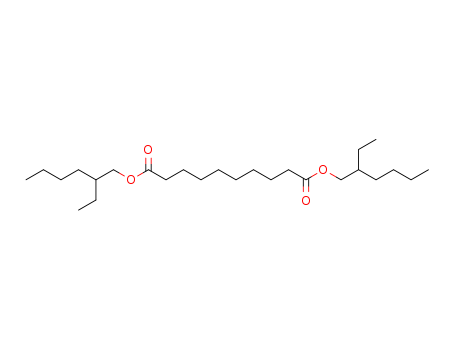
122-62-3
- Product Name:Dioctyl sebacate
- Molecular Formula:C26H50O4
- Purity:99%
- Molecular Weight:426.681
Product Details;
CasNo: 122-62-3
Molecular Formula: C26H50O4
Appearance: colourless or light yellow oily liquid
Quality Factory Supply Wholesale 122-62-3 Dioctyl sebacate with Efficient Delivery
- Molecular Formula:C26H50O4
- Molecular Weight:426.681
- Appearance/Colour:colourless or light yellow oily liquid
- Vapor Pressure:1.29E-13mmHg at 25°C
- Melting Point:-55 °C
- Refractive Index:n20/D 1.450(lit.)
- Boiling Point:435.51 °C at 760 mmHg
- Flash Point:189.655 °C
- PSA:52.60000
- Density:0.914 g/cm3
- LogP:7.62640
Dioctyl sebacate(Cas 122-62-3) Usage
|
Description |
Dioctyl sebacate (DOS) is an organic compound serving as a plasticizer, commonly used for its colorless or light yellow, viscous liquid form with a distinct odor. It possesses low volatility, high plasticizing efficiency, and electrical insulation properties. Primarily utilized in vacuum pumps, DOS is a clear pale yellow liquid that is insoluble in water. Produced by esterifying 2-ethylhexanol with sebacic acid in the presence of an acid catalyst, it is a stable and non-flammable substance. While not classified as flammable or explosive, DOS may react with acids, oxidizing materials, and hydrolyze under acidic or basic conditions. |
|
Uses |
In vacuum pumps. |
|
Production Methods |
Di(2-ethylhexyl) sebacate is manufactured by esterifying 2-ethylhexanol with sebacic acid in the presence of an acid catalyst. |
|
Air & Water Reactions |
Insoluble in water. |
|
Reactivity Profile |
Dioctyl sebacate is an ester. Esters react with acids to liberate heat along with alcohols and acids. Strong oxidizing acids may cause a vigorous reaction that is sufficiently exothermic to ignite the reaction products. Heat is also generated by the interaction of esters with caustic solutions. Flammable hydrogen is generated by mixing esters with alkali metals and hydrides. Dioctyl sebacate can react with oxidizing materials. Dioctyl sebacate will hydrolyze under acidic or basic conditions. |
|
Fire Hazard |
Dioctyl sebacate is probably combustible. |
|
Flammability and Explosibility |
Notclassified |
InChI:InChI=1/C26H50O4/c1-5-9-16-22(7-3)20-26(25(29)30,21-23(8-4)17-10-6-2)19-15-13-11-12-14-18-24(27)28/h22-23H,5-21H2,1-4H3,(H,27,28)(H,29,30)/p-2
122-62-3 Relevant articles
Preparation of nano-SO4 2- /TiO2 catalyst and its application in esterification of sebacic acid with 2-ethyl hexanol
Ji, Xianbing,Chen, Yinxia,Wang, Xiaobo,Liu, Weimin
, p. 222 - 225 (2011)
A pure anatase phase nano-SO 4 2- /TiO2 ...
Exceptionally active and reusable nanobiocatalyst comprising lipase non-covalently immobilized on multi-wall carbon nanotubes for the synthesis of diester plasticizers
Szelwicka, Anna,Boncel, S?awomir,Jurczyk, Sebastian,Chrobok, Anna
, p. 41 - 47 (2019/02/07)
A new method for the synthesis of dicarb...
Micro-flow nanocatalysis: synergic effect of TfOH@SPIONs and micro-flow technology as an efficient and robust catalytic system for the synthesis of plasticizers
Tashi, Maryam,Shafiee, Behnaz,Sakamaki, Yoshie,Hu, Ji-Yun,Heidrick, Zachary,Khosropour, Ahmad R.,Beyzavi, M. Hassan
, p. 37835 - 37840 (2018/11/26)
The combination of continuous flow techn...
Coating Mass Dependence of Soot Aggregate Restructuring due to Coatings of Oleic Acid and Dioctyl Sebacate
R. Ghazi &J. S. Olfert
, Aerosol Science and Technology Volume 47, 2013 - Issue 2
The effect of the mass of coating on the morphology of soot particles was studied using oleic acid and dioctyl sebacate (DOS) coatings. A wide range of coatings were used, with up to 10 times as much coating as the mass of the soot.
122-62-3 Process route
-

- 7327-98-2
decanedioic acid mono-(2-ethyl-hexyl ester)

-

- 111-20-6,26776-29-4
1,10-decanedioic acid

-

- 122-62-3
bis(2-ethylhexyl)sebacate
| Conditions | Yield |
|---|---|
|
at 175 - 200 ℃; Equilibrium constant; Disproportionierung;
|
-

- 111-20-6,26776-29-4
1,10-decanedioic acid

-

- 104-76-7
2-Ethylhexyl alcohol

-

- 122-62-3
bis(2-ethylhexyl)sebacate
| Conditions | Yield |
|---|---|
|
With choline chloride; zinc(II) chloride; at 110 ℃; for 16h;
|
99% |
|
In 5,5-dimethyl-1,3-cyclohexadiene; at 160 ℃; for 2h; Time; Temperature; Concentration;
|
99% |
|
With titanium(IV) isopropylate; at 150 - 215 ℃; for 3.5h; Reagent/catalyst; Temperature; Large scale;
|
97.23% |
|
With toluene-4-sulfonic acid; In 5,5-dimethyl-1,3-cyclohexadiene; at 130 - 140 ℃; for 8h;
|
95% |
|
With triflic acid on silica-encapsulated superparamagnetic iron oxide nanoparticles; In neat (no solvent); at 90 ℃; for 0.25h; Time; Reagent/catalyst; Catalytic behavior; Flow reactor; Green chemistry;
|
92% |
|
With Candida antarctica lipase B; In cyclohexane; at 45 ℃; for 24h;
|
57% |
|
With toluene-4-sulfonic acid; benzene;
|
|
|
With toluene; unter Entfernen des gebildeten Wassers;
|
|
|
With sulfuric acid;
|
|
|
With nano-SO4(2-)/TiO2; for 2h;
|
|
|
With sulfuric acid;
|
|
|
With toluene-4-sulfonic acid; benzene;
|
|
|
With toluene; unter Entfernen des gebildeten Wassers;
|
122-62-3 Upstream products
-
111-20-6

1,10-decanedioic acid
-
104-76-7

2-Ethylhexyl alcohol
-
7327-98-2

decanedioic acid mono-(2-ethyl-hexyl ester)
122-62-3 Downstream products
-
111-20-6

1,10-decanedioic acid
-
1632-16-2

2-ethyl-1-hexene
-
7327-98-2

decanedioic acid mono-(2-ethyl-hexyl ester)
-
75-07-0

acetaldehyde
Relevant Products
-
Azithromycin dihydrate
CAS:117772-70-0
-
Aniracetam
CAS:72432-10-1
-
Sucrose
CAS:57-50-1








